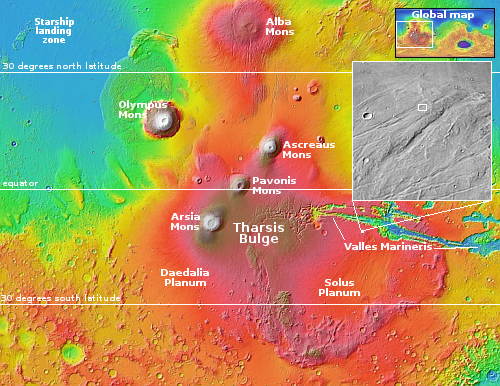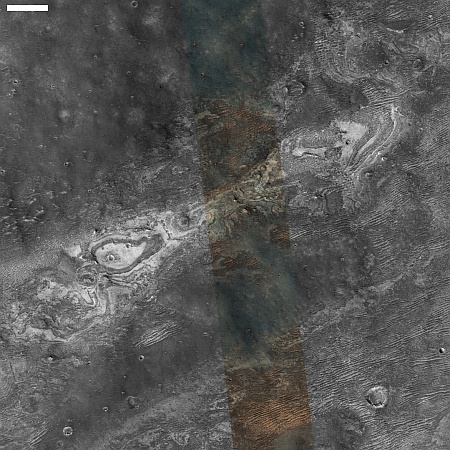Mining Mars
Cool image time! The picture to the right, cropped, reduced, and sharpened to post here, was taken on May 22, 2024 by the high resolution camera on Mars Reconnaissance Orbiter (MRO). The picture’s focus of study is the bright strip running diagonally across the center, which the scientists label as a “linear feature exposure of infrared-bright material.”
This bright strip with all the swirls of alternating light and dark terrain is a fissure about 80 feet deep. What is interesting is that the parallel bright features to the north and south are actually ridges, not depressions, even though there appears to be some resemblance between them all. (Note that the patches of very thin parallel lines are likely ripple dunes sitting on top of the topography.)
So, what created this fissure? And why is its inner surface so strange? As is usually the case, a wider look provides some clues.

The white dot on the overview map to the right marks the location, about 35-50 miles south of the rim of Valles Marineris. The small rectangle in the inset indicates the area covered by the picture above, and shows that this fissure is only a tiny example of a series of parallel much larger fissures, dubbed Sinai Fossae, all of which are located on a 100-mile-wide bulge dubbed Sinai Dorsa that stretches 200 miles to the south where it meets up with a high point dubbed Sinai Tholus that appears to have been a source of volcanic flood lava.
Thus we can speculate that upward pressure from magma under Sinai Tholus pushed up the bulge, causing cracks to form within which bubbled lava. In the specific fissure above, when that lava froze it did so while it swirled about, with the outer edges hardening first. Thus the alternating bands of light and dark.
More important, the orbital data that finds this fissure to be very bright in the infrared suggests those swirls likely contain a lot of mineralized material, making this a potential valuable mining location. Global orbital data has found a lot of hydrated sulfates both here as well as permeating the south slopes and floor of nearby Valles Marineris. The “hydrated” nature of these sulfates tells us that water was somehow involved in their formation. Their “sulfate” nature tells us that there is likely a lot of valuable minerals located here as well.
Thus, this region is likely going to an important mining region for future settlers.
On Christmas Eve 1968 three Americans became the first humans to visit another world. What they did to celebrate was unexpected and profound, and will be remembered throughout all human history. Genesis: the Story of Apollo 8, Robert Zimmerman's classic history of humanity's first journey to another world, tells that story, and it is now available as both an ebook and an audiobook, both with a foreword by Valerie Anders and a new introduction by Robert Zimmerman.
The print edition can be purchased at Amazon or from any other book seller. If you want an autographed copy the price is $60 for the hardback and $45 for the paperback, plus $8 shipping for each. Go here for purchasing details. The ebook is available everywhere for $5.99 (before discount) at amazon, or direct from my ebook publisher, ebookit. If you buy it from ebookit you don't support the big tech companies and the author gets a bigger cut much sooner.
The audiobook is also available at all these vendors, and is also free with a 30-day trial membership to Audible.
"Not simply about one mission, [Genesis] is also the history of America's quest for the moon... Zimmerman has done a masterful job of tying disparate events together into a solid account of one of America's greatest human triumphs."--San Antonio Express-News
Cool image time! The picture to the right, cropped, reduced, and sharpened to post here, was taken on May 22, 2024 by the high resolution camera on Mars Reconnaissance Orbiter (MRO). The picture’s focus of study is the bright strip running diagonally across the center, which the scientists label as a “linear feature exposure of infrared-bright material.”
This bright strip with all the swirls of alternating light and dark terrain is a fissure about 80 feet deep. What is interesting is that the parallel bright features to the north and south are actually ridges, not depressions, even though there appears to be some resemblance between them all. (Note that the patches of very thin parallel lines are likely ripple dunes sitting on top of the topography.)
So, what created this fissure? And why is its inner surface so strange? As is usually the case, a wider look provides some clues.

The white dot on the overview map to the right marks the location, about 35-50 miles south of the rim of Valles Marineris. The small rectangle in the inset indicates the area covered by the picture above, and shows that this fissure is only a tiny example of a series of parallel much larger fissures, dubbed Sinai Fossae, all of which are located on a 100-mile-wide bulge dubbed Sinai Dorsa that stretches 200 miles to the south where it meets up with a high point dubbed Sinai Tholus that appears to have been a source of volcanic flood lava.
Thus we can speculate that upward pressure from magma under Sinai Tholus pushed up the bulge, causing cracks to form within which bubbled lava. In the specific fissure above, when that lava froze it did so while it swirled about, with the outer edges hardening first. Thus the alternating bands of light and dark.
More important, the orbital data that finds this fissure to be very bright in the infrared suggests those swirls likely contain a lot of mineralized material, making this a potential valuable mining location. Global orbital data has found a lot of hydrated sulfates both here as well as permeating the south slopes and floor of nearby Valles Marineris. The “hydrated” nature of these sulfates tells us that water was somehow involved in their formation. Their “sulfate” nature tells us that there is likely a lot of valuable minerals located here as well.
Thus, this region is likely going to an important mining region for future settlers.
On Christmas Eve 1968 three Americans became the first humans to visit another world. What they did to celebrate was unexpected and profound, and will be remembered throughout all human history. Genesis: the Story of Apollo 8, Robert Zimmerman's classic history of humanity's first journey to another world, tells that story, and it is now available as both an ebook and an audiobook, both with a foreword by Valerie Anders and a new introduction by Robert Zimmerman.
The print edition can be purchased at Amazon or from any other book seller. If you want an autographed copy the price is $60 for the hardback and $45 for the paperback, plus $8 shipping for each. Go here for purchasing details. The ebook is available everywhere for $5.99 (before discount) at amazon, or direct from my ebook publisher, ebookit. If you buy it from ebookit you don't support the big tech companies and the author gets a bigger cut much sooner.
The audiobook is also available at all these vendors, and is also free with a 30-day trial membership to Audible.
"Not simply about one mission, [Genesis] is also the history of America's quest for the moon... Zimmerman has done a masterful job of tying disparate events together into a solid account of one of America's greatest human triumphs."--San Antonio Express-News


